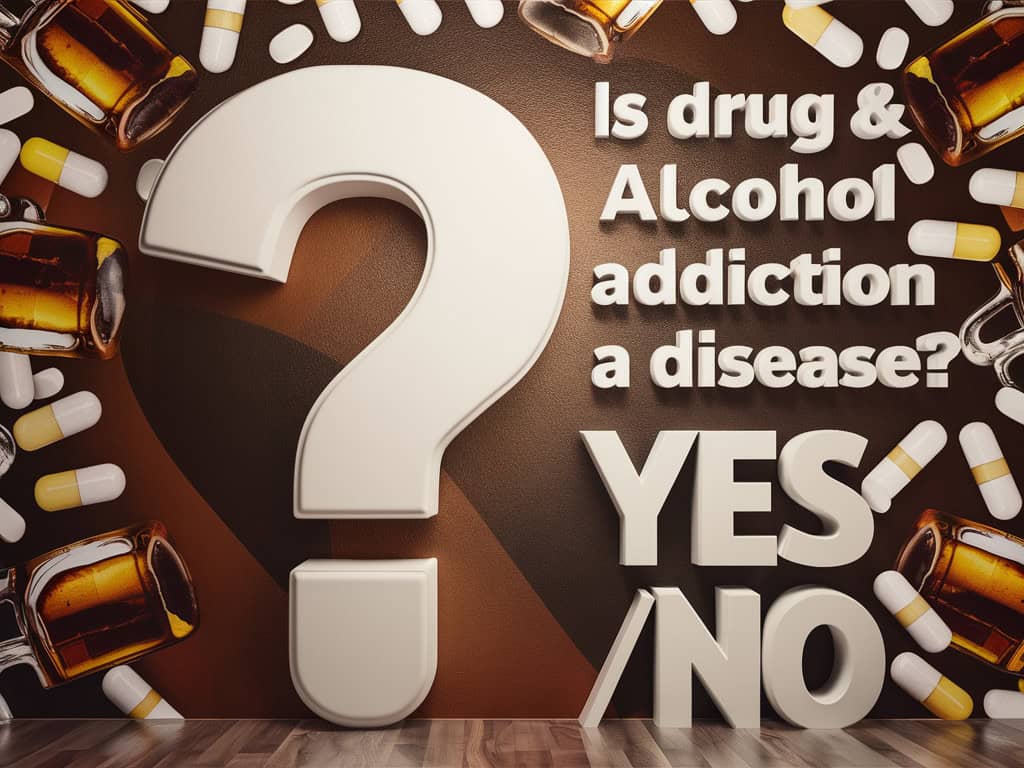Addiction, whether to alcohol or drugs(or both) is frequently surrounded by misconceptions and stigma. However, this disease is more and more regarded as a chronic disease, not a moral failing. This article will discuss the complexity of addiction as a medical condition, covering its biological foundations, the efficacy of different treatment approaches, and the critical importance of understanding addiction as a disease to societal understanding and individual recovery. By viewing addiction from a medical perspective we are able to better help those involved and enhance recovery outcomes.
Key Takeaways
| Aspect | Detail |
| Addiction Definition | Defined as a complex, chronic disease characterized by compulsive substance use despite harm. |
| Disease Model | Supports addiction as a medical condition with biological, psychological, and social factors. |
| Treatment Options | Emphasizes the need for comprehensive treatment options such as medical detox and counseling. |
| Common Signs of Addiction | Talks about those struggling with addiction withdraw from family and friends and lose interest in activities they once enjoyed. |
What Is Substance Addiction?
Substance addiction, which is also referred to as substance use disorder, is a condition that involves the uncontrol urge to use drugs or alcohol even though adverse consequences occur. It goes beyond habit and involves a very complicated web of psychological, physical, and social dynamics. At its core, addiction disrupts the brain’s reward circuitry, altering how one experiences pleasure and reward. Substances that foster addiction can trigger an intense release of dopamine, a neurotransmitter associated with pleasure and satisfaction, making the experience of using the substance highly desirable and, over time, seemingly necessary for well-being.
As the condition progresses, individuals often exhibit a persistence of substance use despite significant impairment and distress. This includes detrimental impacts on health, disruptions in personal and professional relationships, and potential legal issues. Intense cravings, tolerance to the substance, and withdrawal symptoms are all stages of the addiction cycle. These symptoms can compel individuals to continue using the substance as a way to avoid discomfort, thereby perpetuating a cycle that can be challenging to break without appropriate medical and psychological intervention. For more detailed information on understanding and identifying substance addiction, you can visit our general treatment overview page.
Understanding Drug and Alcohol Addiction as a Disease
Addiction, which includes drug and alcohol dependencies, is widely recognized in the medical community as a chronic disease. This view is supported by findings of numerous studies that detail the drastic changes addictive substances produce in brain chemistry and anatomy. Just like other chronic diseases such as diabetes or cardiovascular disease, addiction is a condition that affects the normal, healthy functioning of a healthy body organ, or the brain in this case. For more addiction insights, visit our comprehensive overview of addiction.
The disease model of addiction is one of the most important and widely accepted theories, which explains how environmental, genetic, and neurobiological factors lead to the development of addiction as a disease. This model aligns with treatments similar to those used for managing other chronic diseases, including ongoing management and interventions to prevent relapse.
Why Are Drugs and Alcohol Addictive?
Drugs rob the brain of the normal reward mechanism. Over time, the brain becomes accustomed to the pleasure produced by addictive substances, which makes the substance seem to be the only way to feel pleasure or normal. When drugs reach the brain, they can mimic and replace the natural chemicals normally present in the brain. They trigger the release of chemicals and block the brain from recycling and reabsorbing those chemicals.
Without intervention, the desire for drugs or alcohol becomes a natural reflex, and cravings can be overwhelming. Detailed information on the physiological impacts of alcohol can be found on our alcohol addiction treatment page.
Is Drug or Alcohol Addiction a Choice?
Whether addiction to drugs or alcohol is a matter of choice or not is a controversial question that is entwined with many misunderstandings and prejudice. In the beginning, the option to use a substance is usually voluntary. However, once addiction develops, the capacity to choose is compromised. Addiction profoundly alters the brain’s chemistry and function, particularly in areas governing judgment, decision-making, learning, memory, and behavior control. These changes can make the act of choosing not to use a substance extraordinarily difficult, if not impossible, without professional intervention. Why would some say addiction is not a choice?
- Drugs or alcohol addiction itself is neither transmissible nor contagious.
- Drugs or alcohol addiction isn’t hereditary, degenerative, or autoimmune.
- Drugs or alcohol addiction is a condition given to oneself.
Addiction, when described as a choice, does not take into account the biology and the environmental factors that contribute to the disease. Genetic predispositions, mental health disorders, trauma, and social environments have been proven to be the most influential factors that determine susceptibility to addiction. Furthermore, after the use of substance becomes a cycle, the addiction loses its character as a matter of willpower or moral weakness. It becomes a neurobiological disorder that needs complex treatment and care, which, in turn, highlights the role of a medical, not a moralistic, point of view on addiction. This understanding is fundamental to effective treatment methods and also helps eliminate the stigmatization of addiction which can often prevent those affected from seeking the help they need.
What Are Common Signs of Addiction?
Identifying the signs of addiction is essential for early intervention and successful treatment. The signs can be subtle initially but become more pronounced as the addiction progresses. Common indicators include an increased tolerance to the substance, meaning the individual needs more of it to achieve the same effects. Withdrawal symptoms can appear when the substance is not used and include shaking, nausea, mood swings, and fatigue. Behavioral changes are also notable; individuals may spend significant time obtaining, using, or recovering from the effects of the substance.
From a social standpoint, people with addiction often distance themselves from their families and friends and stop enjoying activities they used to like. They neglect their duties at work or school and could engage in dangerous activities, for instance, driving under the influence or use of dirty needles. Financial difficulties are another common sign, as resources may increasingly be directed toward sustaining the addiction. These signs all suggest that substance use is no longer a choice but a compulsion, highlighting the need for professional help and support, which can be further explored through our treatment options for addiction.
Treatment Approaches: The Need for Medical Detox and Rehabilitation
Recognizing addiction as a disease necessitates a structured treatment approach, starting with detoxification that addresses the physical dependence on substances. Alcohol and drug detox is a core component of treatment and includes medically supervised withdrawal under the full supervision of a medical professional and prepares an individual for behavioral therapies and support programs. Learn more about our specific approaches to detox on our drug detox page and alcohol detox page.
Find Drug Rehab and Detox Treatment Centers Near You
Find facilities that specialize in addiction treatment

FAQ
Q: What is addiction?
A: Addiction is a chronic, relapsing disorder characterized by compulsive drug seeking, continued use despite harmful consequences, and long-lasting changes in the brain.
Q: What Are Signs of Addiction?
A: Signs of addiction can include a persistent desire to use the substance, unsuccessful efforts to cut down, withdrawal symptoms, and continued use despite knowing the harmful effects.
Q: Is addiction a disease?
A: Yes, addiction is considered a disease because it involves changes to the brain’s structure and function. It affects the brain’s reward system, decision-making, and impulse control.
Q: Can addiction be treated?
A: Yes, addiction is treatable. Effective treatment involves a combination of medical detox, behavioral therapies, medication, and support groups to help maintain long-term recovery.
Q: Is there a cure for addiction?
A: While there is no cure for addiction, it can be effectively managed. Continuous treatment and support can enable individuals to counteract addiction’s disruptive effects and regain control of their lives.
Q: How does addiction affect the brain?
A: Addiction alters the brain’s reward system and disrupts the balance of neurotransmitters that regulate mood, behavior, and responses to stress.
Q: Why is addiction considered a chronic disease?
A: Like diabetes, cancer, and heart disease, addiction is considered chronic because it involves cycles of relapse and remission, requires ongoing management, and can have lasting effects on the body.
Sources
Understanding Alcohol Use Disorder – National Institute on Alcohol Abuse and Alcoholism (NIAAA) [*]
Substance Use Disorder: MedlinePlus Medical Encyclopedia [*]
Addiction: What It Is, Causes, Symptoms, Types & Treatment – Cleveland Clinic [*]
Drug addiction (substance use disorder) – Symptoms and causes – Mayo Clinic [*]
Substance Misuse and Substance use Disorders: Why do they Matter in Healthcare? – Johns Hopkins Medicine [*]
5 Controversial Thoughts We Have About Addiction – DrugAbuse.com [*]
Treatment for Alcohol Problems: Finding and Getting Help – National Institute on Alcohol Abuse and Alcoholism (NIAAA) [*]
These sources collectively provide a nuanced understanding of drug and alcohol addiction as a disease, including the scientific basis for this classification, treatment strategies, and ongoing debates within the field.



























